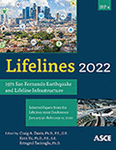Contaminant Migration from Polymer Pipes to Drinking Water under High Temperature Wildfire Exposure
Publication: Lifelines 2022
ABSTRACT
The intensity, severity, and frequency of wildfires throughout the world have significantly increased in recent years, causing damage to structures and lifeline infrastructure in wildland urban interface communities. The 2018 Camp Fire in California damaged nearly 19,000 structures in Butte County and caused widespread contamination of the water within the water distribution system (WDS) in Paradise. The water contamination led to a town-wide water advisory shutoff, impeding recovery of the town as schools, hospitals, and commercial businesses were unable to reopen immediately following the fire. The objective of this research is to explore the relationship between pipe material, pipe temperature, heating duration, and chemical contamination of water within buried water distribution networks, specifically during wildfire heating of service lateral water pipes. This research aims to investigate lifeline resilience through understanding the impact of wildfire on different service pipeline materials and the effect that pipe material may have in the recovery of WDSs after a wildfire. To better understand the impact of temperature and heating duration on pipe materials, the authors perform a series of experiments to determine the critical temperature and duration of heating at which contaminants migrate from pipes into contained water. This paper will help inform utilities of the potential water contamination risk posed by wildfire hazards.
Get full access to this article
View all available purchase options and get full access to this chapter.
REFERENCES
ASTM. (2014). Standard Specification for Poly(Vinyl Chloride) (PVC) Profile Gravity Sewer Pipe and Fittings Based on Controlled Inside Diameter (ASTM F794-03).
AWWA. (2007). Crosslinked polyethylene (PEX) pressure pipe, 1/2 in (12 mm) through 3 in (76 mm), for water service.
AWWSC. (2002). Deteriorating buried infrastructure management challenges and strategies.
Bruneau, M., Chang, S. E., Eguchi, R. T., Lee, G. C., O’Rourke, T. D., Reinhorn, A. M., Shinozuka, M., Tierney, K., Wallace, W. A., and von Winterfeldt, D. (2003). A Framework to Quantitatively Assess and Enhance the Seismic Resilience of Communities. Earthquake Spectra, 19(4), 733–752.
SWRCB (California State Water Resources Control Board). (2018). Drinking water notification levels and response levels: An overview. https://www.waterboards.ca.gov/drinking_water/certlic/drinkingwater/documents/notificationslevels/notification_levels_response_levels_overview.pdf.
Chong, N. S., Abdulramoni, S., Patterson, D., and Brown, H. (2019). Releases of fire-derived contaminants from polymer pipes made of polyvinyl chloride. Toxics, 7(57).
Disaster Resilience: A national imperative. (2012). In National Research Council. National Research Council. https://www.nap.edu/catalog/13457/disaster-resilience-a-national-imperative.
Emelko, M. B., Silins, U., Blandon, K. D., and Stone, M. (2011). Implications of land disturbance on drinking water treatability in a changing climate: Demonstrating the need for “source water supply and protection” strategies. Water Research, 45(2), 461–472.
Government of Saskatachewan, Ministry of Environment. Health and Environmental Effects of Burning Waste Plastics (Bulletin 433). (September 2012). http://www.saskh2o.ca/PDF/epb433.pdf.
Oosterkamp, A. (2017). Study of soil heat transfer of a natural gas pipeline. International Journal of Offshore and Polar Engineering, 27(1), 90–101.
PPI (Plastic Pipe Institute). (2009). Frequently asked questions: HDPE pipe for water distribution and transmission applications. Plastic Pipe Institute (PPI), Irving, TX.
Proctor, C. R., Lee, J., Yu, D., Shah, A. D., and Whelton, A. J. (2020). Wildfire caused widespread drinking water distribution network contamination. AWWA Water Science.
Schoennagel, T., Balch, J. K., Brenkert-Smith, H., Dennison, P. E., Harvey, B. J., Krawchuk, M. A., Mietkiewicz, N., Morgan, P., Moritz, M. A., Rasker, R., Turner, M. G., and Whitlock, C. (2017). Adapt to more wildfire in western North American forests as climate changes. PNAS, 114(18), 4582-4590. www.pnas.org/cgi/doi/10.1073/pnas.1617464114.
Schulze, S. S., and Fischer, E. C. (2020). Prediction of water distribution system contamination based on wildfire burn severity in wildland urban interface communities. ACS ES&T Water, 1(2), 291-299.
Smith, H. G., Sheridan, G. J., Lane, P. N. J., Nyman, P., and Haydon, S. (2011). Wildfire effects on water quality in forest catchments: A review with implications for water supply. Journal of Hydrology, 396(1–2), 170–192.
SWRCB. (2019). MCLs, DLRs, and PHGs for regulated drinking water contaminants. https://waterboards.ca.gov/drinking_water/certlic/drinkingwater/documents/mclreview/mcls_drls_phgs.xls.
USEPA. (1992). Method 524.2: Measurement of Purgeable Organic Compounds in Water by Capillary Column Gas Chromatography/Mass Spectrometry. Cincinnati, OH.
USEPA. (n.d.). Public notification - Drinking water system pressure loss boil advisory template. https://www.epa.gov/sites/production/files/documents/pn_pressureloss_boiladvisory_0.pdf.
Vollaro, R. D. L., Fontana, L., and Vallati, A. (2011). Thermal analysis of underground electrical power cables buried in non-homogeneous soils. Applied Thermal Engineering, 31(5), 772–778. https://doi.org/10.1016/j.applthermaleng.2010.10.024.
Whelton, A. J., Dietrich, A. M., and Gallagher, D. L. (2010). Contaminant diffusion, solubility, and material property differences between HDPE and PEX potable water pipes. Journal of Environmental Engineering, 136(2), 227–237.
Whelton, A. J., and Nguyen, T. (2013). Contaminant migration from polymeric pipes used in buried potable water distributions systems: A Review. Critical Reviews in Environmental Science and Technology, 43(7), 679–751.
Information & Authors
Information
Published In
History
Published online: Nov 16, 2022
Authors
Metrics & Citations
Metrics
Citations
Download citation
If you have the appropriate software installed, you can download article citation data to the citation manager of your choice. Simply select your manager software from the list below and click Download.
